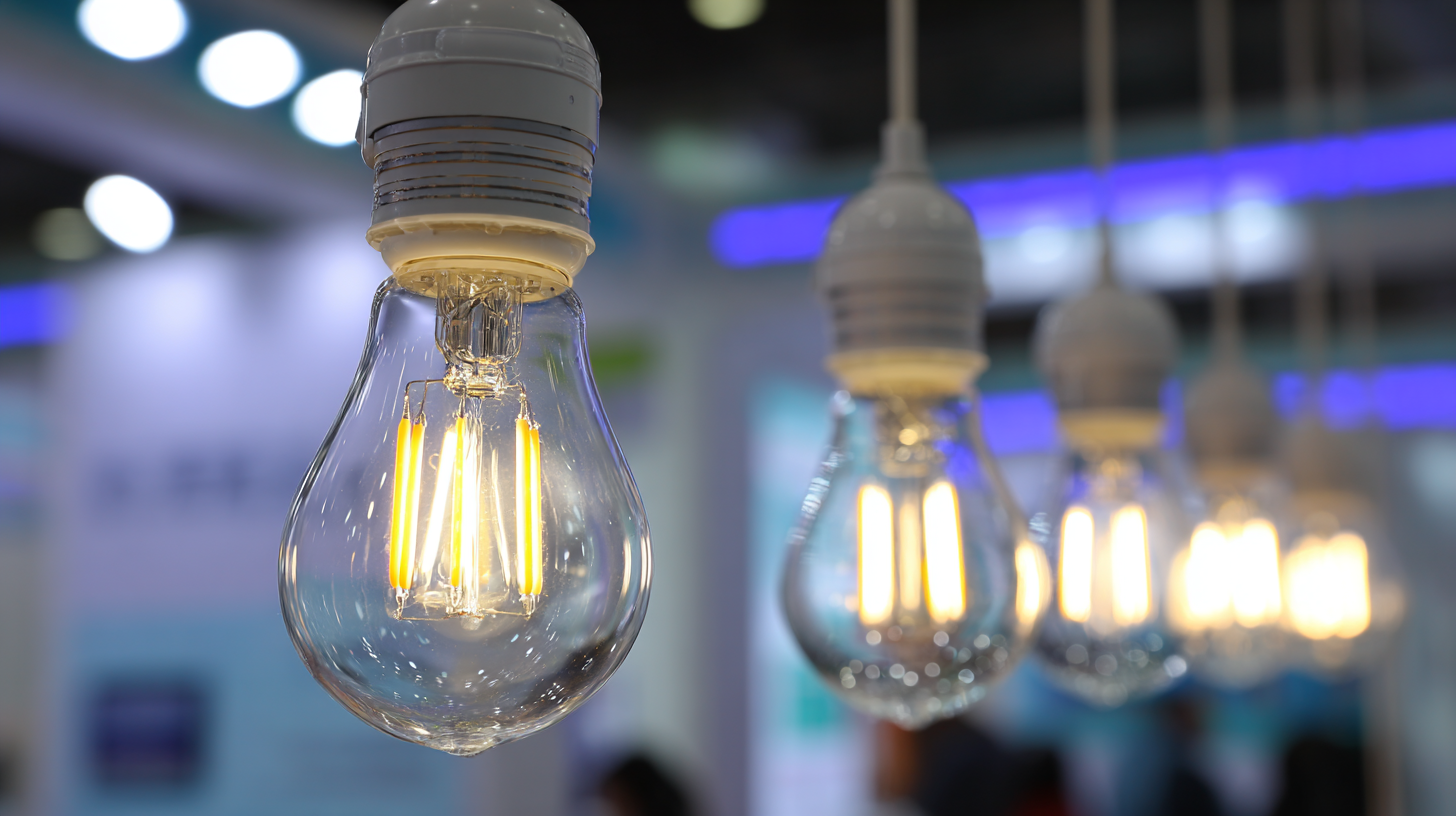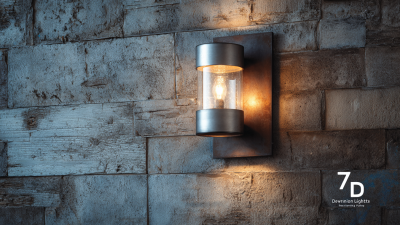Exploring Industry Trends for Led Light Bulbs at the 138th Canton Fair China 2025
As the 138th Canton Fair approaches in 2025, the spotlight on LED light bulbs continues to intensify amid a rapidly evolving industry landscape. Recent market analysis reports indicate that the global LED lighting market is projected to reach approximately $160 billion by 2027, growing at a CAGR of 13.3% from 2020 to 2027. This surge in demand is primarily driven by the increasing awareness of energy efficiency and the cost-saving benefits of LED technology. Furthermore, advancements in smart lighting solutions are set to revolutionize how consumers interact with lighting in both residential and commercial sectors.

As industry leaders and innovators converge at the Canton Fair, the exhibition will serve as a pivotal platform for showcasing the latest trends, technological advancements, and sustainability efforts surrounding LED light bulbs, ultimately shaping the future of the lighting industry.
Key Innovations in LED Light Bulb Technology Showcased at the 138th Canton Fair
The 138th Canton Fair is set to showcase significant advancements in LED light bulb technology, highlighting innovations that are reshaping the industry. As the market for LED lighting continues to expand, projected to reach $80 billion by 2027, companies are focusing on developing energy-efficient solutions that meet both consumer demands and sustainability goals. One remarkable launch at the fair is the introduction of a proprietary LED chip brand aimed at enhancing performance and brand identity. This initiative not only strengthens the core capabilities of the brand but also positions it competitively in the rapidly evolving LED lighting market.

Recent industry reports indicate that the annual growth rate of the global LED lighting market is expected to remain around 13% through 2025. Innovations showcased at the Canton Fair will likely include advancements in chip technology, such as improved luminosity and efficiency, which are essential for meeting rigorous energy standards. Additionally, trends are shifting toward smart lighting solutions that integrate with IoT devices, further driving innovation and adoption among consumers. The emphasis on customization and high-quality light output will play a pivotal role in responding to market demands, as industry players look to differentiate themselves in this dynamic environment.
Market Demand Analysis for LED Lighting Solutions in China and Beyond
The global lighting market was valued at approximately $139.79 billion in 2023 and is projected to grow to $367.88 billion by 2032, demonstrating significant potential for LED lighting solutions. With an anticipated growth from $154.27 billion in 2024 to $295.4 billion by 2032, the industry is expected to experience a compound annual growth rate (CAGR) of 8.5% during this forecast period. This growth reflects increasing demand not only in domestic markets but also in international sectors, indicating a robust market for LED technologies, particularly in the context of sustainable and energy-efficient lighting solutions.
In the industrial segment, visual comfort and functionality are paramount, leading companies to focus on developing LED lighting designs that enhance productivity and worker well-being. As highlighted by recent market analysis, the focus on the visual environment, influenced by lighting direction, shape, and color, directly impacts employee mood and efficiency. Notably, the export of industrial lighting solutions was valued at $1.5 billion in the fourth quarter of 2021, showcasing the competitive landscape where domestic leaders strive to capture both local and global market share in this rapidly evolving industry.

Sustainability and Environmental Impact of LED Lighting Trends at the Fair
The 138th Canton Fair in 2025 will showcase the burgeoning trends in LED light bulbs, particularly focusing on sustainability and their environmental impact. According to the International Energy Agency (IEA), the global LED market is expected to grow to $125 billion by 2027, driven largely by advancements in energy-efficient technology. LED lighting consumes up to 75% less energy compared to traditional incandescent bulbs, resulting in significant reductions in greenhouse gas emissions. Additionally, the lifespan of LED bulbs, which can last up to 25,000 hours, not only decreases waste but also minimizes the frequency of replacements, further enhancing their eco-friendly appeal.
As manufacturers increasingly prioritize sustainability, many are adopting circular economy principles in their product designs. For instance, the Global Lighting Association reports that several leading companies are now focusing on recyclable materials for LED bulb casings and utilizing low-impact manufacturing processes. This shift not only meets growing consumer demand for reducing environmental footprints but also aligns with international regulations aimed at limiting harmful waste.
Tips: When selecting LED lighting, consider opting for products with Energy Star certification to ensure high energy efficiency and lower environmental impact. Additionally, check for manufacturers that embrace sustainable practices, such as using recyclable materials and committing to reduced energy consumption in their production processes. This not only supports eco-friendly initiatives but also contributes to long-term cost savings for consumers.
Exploring Industry Trends for LED Light Bulbs at the 138th Canton Fair China 2025
This chart illustrates the key trends in LED lighting as analyzed during the 138th Canton Fair in China 2025, highlighting the importance of factors such as energy efficiency and sustainability in the industry.
Competitive Landscape: Key Players in the LED Bulb Industry at the Canton Fair
The competitive landscape of the LED bulb industry at the 138th Canton Fair in China reveals a dynamic array of key players, each showcasing their latest innovations. Major brands such as Philips, Osram, and Cree were present, demonstrating their advanced technologies and energy-efficient solutions. These companies are not only competing on product quality but also on sustainability and design, which are increasingly important to consumers. Their booths attracted significant attention, reflecting the growing demand for LED products that combine functionality with environmental responsibility.
In addition to established companies, several emerging brands also made a mark at the fair. Many of these newer entrants highlighted unique features, such as smart technology integration and customizable lighting options, appealing to a tech-savvy audience. The competition fosters an environment of rapid innovation, driving the industry toward better performance and cost-effectiveness. As consumer preferences shift towards more eco-friendly products, these key players are adapting by incorporating recycled materials and improving energy efficiency, highlighting the industry's commitment to sustainability while vying for market leadership.
Future Projections: The Evolution of LED Lighting Markets through 2025 and Beyond
As we explore the future of LED lighting markets through 2025 and beyond, the ongoing shifts in energy prices and technological advancements are key factors shaping this evolution. Following an increase in energy costs during the "energy crisis," prices have somewhat stabilized, yet remain significantly higher than pre-crisis levels. This context is driving consumers and businesses alike towards energy-efficient solutions, with LED technology standing out as a prime candidate. As noted in recent reports, the global shift towards energy efficiency is expected to propel the LED lighting market to grow by over 15% annually, reflecting an increasing demand for sustainable alternatives.
In addition, the technology industry's growth trajectory, projected to be strengthened by enhanced IT expenditures and investments in artificial intelligence, will likely influence the LED market. As companies innovate and improve product offerings, the integration of smart technologies into LED solutions becomes increasingly prevalent. Industry reports suggest that by 2025, a significant portion of LED products will incorporate advanced features such as Internet of Things (IoT) connectivity, further driving consumer interest and adoption. Thus, the evolution of the LED lighting market is not only a response to energy costs but also a result of rapid technological advancements shaping consumer expectations and industry standards.
Exploring Industry Trends for Led Light Bulbs at the 138th Canton Fair China 2025
| Year | Market Size (USD Billion) | Growth Rate (%) | Key Drivers | Applications |
|---|---|---|---|---|
| 2021 | 22.3 | 12.5 | Energy Efficiency, Government Regulations | Residential, Commercial |
| 2022 | 25.0 | 11.9 | Sustainability Trends, Technological Advancements | Outdoor, Industrial |
| 2023 | 28.8 | 14.2 | Smart Lighting, IoT Integration | Smart Homes, Hospitality |
| 2024 | 32.1 | 11.5 | Climate Change Awareness, LED Adoption | Healthcare, Educational Institutions |
| 2025 | 36.7 | 14.3 | Rising Urbanization, Policy Support | Transportation, Infrastructure |
Related Posts
-

Maximize Your Investment with 7 Essential Tips on Repair Costs and After Sales Support for Led Fixtures
-

Explore the Benefits of Switching to Energy Efficient LED Light Bulbs Today
-

Maximizing Cost Efficiency with LED Light Bulbs Through Smart Maintenance Strategies
-

Illuminate Your Space with the Versatility of Dimmable LED Light Bulbs
-

7 Best Wall Lights to Transform Your Space: Enhancing Ambiance with Energy-Efficient Solutions
-

Innovative Solutions for Optimizing LED Driver Performance

